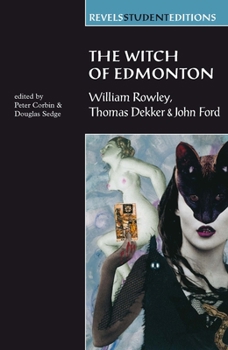The Witch of Edmonton: By William Rowley, Thomas Dekker and John Ford
Select Format
Select Condition 
Book Overview
The Witch of Edmonton has received considerable attention recently both from scholars and critics interested in witchcraft practices and also from the directors in the theatre. The play, based on a sensational witchcraft trial of 1621, presents Mother Sawyer and her local community in the grip of a witch-mania reflecting popular belief and superstition of the time. This edition offers a thorough reconsideration of the text with a complete transcription of the original pamphlet by Henry Goodcole. This edition will be of particular interest not only to students of Renaissance Drama but also of the cultural history of the seventeenth century.. Open University adopted text (for their new Renaissance Drama module).
Format:Paperback
Language:English
ISBN:0719052475
ISBN13:9780719052477
Release Date:October 1999
Publisher:Manchester University Press
Length:160 Pages
Weight:0.41 lbs.
Dimensions:0.5" x 5.0" x 7.7"
Customer Reviews
1 rating
Entertaining Plot - Methuen Student Edition is Great
Published by Thriftbooks.com User , 22 years ago
I look unfavorably upon books and screenplays rushed to the market to capitalize on recent sensational jury trials, confessions of serial murderers, and distasteful behavior by politicians and other celebrities. I would consider it unlikely that I would appreciate a play rapidly assembled by three playwrights on the recent execution of a notorious old woman condemned for practicing witchcraft. Surprisingly, I did enjoy such a play. Admittedly, a few centuries have elapsed since Thomas Dekker and John Ford and William Rowley collaborated on The Witch of Edmonton. The Mother Sawyer subplot is apparently faithful to the actual event; Sawyer was hanged on April 19, 1621. Within days the chaplain of Newgate Gaol published a pamphlet titled The Wonderful Discoverie of Elizabeth Sawyer a Witch, late of Edmonton, her Conviction and Condemnation and Death. This document served as the primary source for Dekker, Ford, and Rowley. The first known performance was December 29, 1621 at the Court of King James, but earlier public performances are likely to have occurred. Many books, plays, (and now screenplays) on topical events are quickly forgotten. Fortunately, after several centuries of neglect, The Witch of Edmonton was republished in the late 1800s, most importantly in the influential Mermaid Series. More recently several major production companies, including the Royal Shakespeare Company, have staged The Witch of Edmonton. The short prologue to this play ends with the sentence: 'Here is mirth and matter.' However, most readers will agree that The Witch of Edmonton has only a few elements of comedy and that matter clearly overwhelms mirth. The plot involves two intertwined themes, both stories of betrayal and deceit and misplaced loyalty: 1) To gain a dowry, the young Frank Thorney deceives all that trust him, commits bigamy, and even murder. 'Tis done, and I am in. Once past our height, we scorn the deepest abyss' 2) Living in isolation, feared and abused by her neighbors, Mother Sawyer pleads for help. 'Would some power, good or bad, instruct me which way I might be revenged.' The devil in the guise of a dog obliges Mother Sawyer in return for her soul. The Witch of Edmonton is interesting, entertaining drama. The characters do not have the psychological depth found in Shakespeare's tragedies, but this play warrants reading by anyone that enjoys Elizabethan and Jacobean drama. I highly recommend the Methuen Student Edition. The extensive commentary, plot analysis, and character reviews are excellent.





